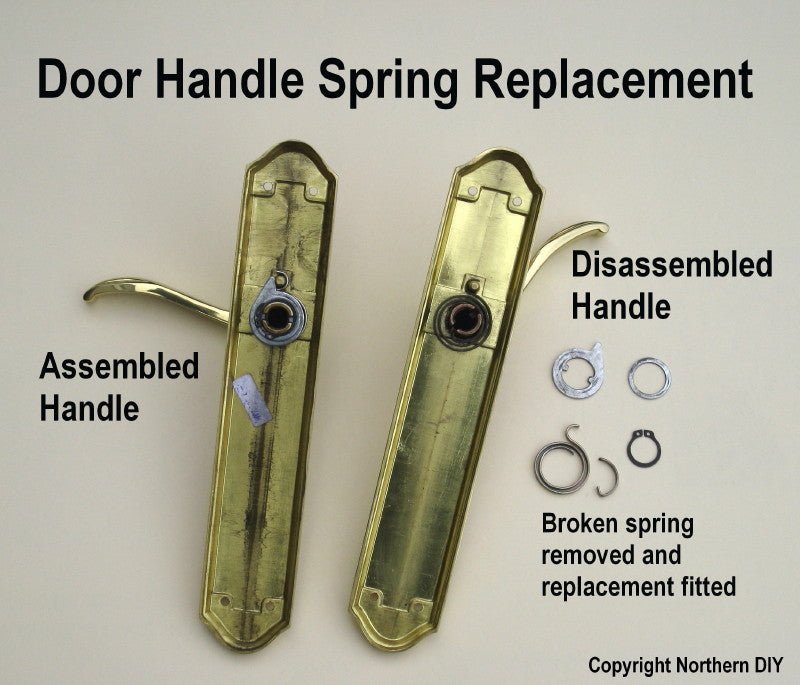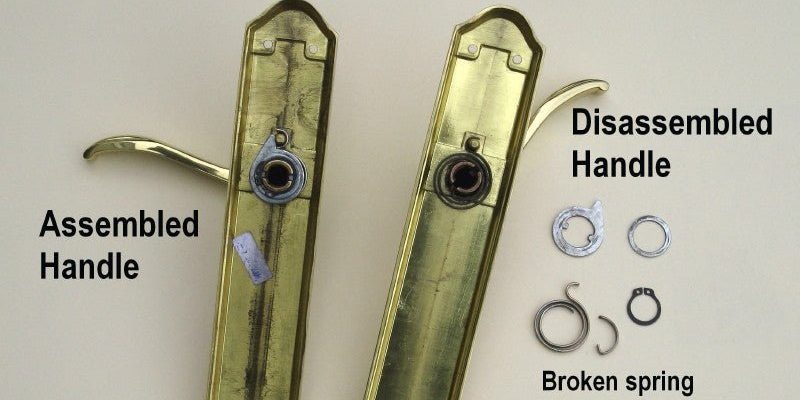
What’s really going on here? Picture the door knob and its spindle like two gears in a clock: when they connect and move together, things work smoothly. But if something comes loose or wears out, that “gear” action disappears and everything just spins. The good news? You usually don’t need to call a locksmith or rush out for an expensive replacement. With a bit of troubleshooting, a screwdriver, and some patience, you can fix a spinning exterior door knob yourself.
What Causes an Exterior Door Knob to Spin Freely?
Honestly, when your door knob is spinning with no resistance, there are a few common culprits. Over time, screws can work themselves loose, or the internal parts—like the spindle or latch—can wear out or break. For most brands (think Schlage, Kwikset, Defiant, and similar), the basic mechanics are the same. The spindle is a metal rod that connects one side of the knob to the other and passes through the latch mechanism inside the door. If that rod isn’t properly connected, or if the latch mechanism itself is shot, you’ll get that annoying spin.
Maybe you’ve noticed other signs before the spinning started. If you had to jiggle the knob or felt extra play when turning it, that was likely a warning. Sometimes, extreme weather or a door that swells and shrinks can also put stress on the hardware, speeding up wear. In rare cases, an improper installation at the start (like not tightening screws enough) can let problems bubble up months or years later.
You might be wondering: does the brand matter? Most knob designs—whether it’s a Yale, Kwikset, or even a universal Amazon model—use very similar code in their internal build. The troubleshooting steps will usually apply regardless. Still, some premium brands have extra security fasteners or anti-tamper features, which can add a twist to your repair. But at the heart of it, it almost always comes down to the spindle, screws, or latch mechanism.
How Your Door Knob Mechanism Works
Let me explain how these things actually work. On a basic level, a door knob isn’t that complicated, but the details really matter. The spindle is a square metal rod that runs between the two knobs on either side of the door. When you twist the knob, the spindle turns and pulls back the latch, letting the door open. The knobs themselves are held on by small set screws or mounting screws, which keep everything snug and in sync.
Inside, the latch mechanism is what actually keeps the door closed. It slides into place when the door is shut and retracts when you turn the knob. If the spindle isn’t properly seated in the latch, or if the screws are loose, the spindle will just spin in place and not budge the latch. That’s when you get the “spins freely” problem.
You know you’ve got a spindle issue if both the exterior and interior knobs just spin around, and the latch doesn’t move. If only one side spins, the problem might be with the set screw or knob on that particular side. And in some cases, especially with older doors, the spindle itself might be stripped or broken, meaning it can’t grip the latch at all. It’s all about making sure everything fits tightly, locks together, and moves as one unit.
What You’ll Need: Tools and Materials
Before you start, it helps to have everything ready. Luckily, most door knob repairs are beginner-friendly and you don’t need a massive toolkit. Here’s what you’ll want nearby:
- Phillips or flat-head screwdriver (depending on your screws)
- Replacement screws (if the originals are stripped or missing)
- Allen wrench (for set screws on some brands, like Schlage or Yale)
- WD-40 or a light lubricant (optional, if moving parts are sticky or rusty)
- Replacement spindle or latch (only if yours is broken or stripped)
- Paper towel or rag (for cleaning out dust or debris)
Keep in mind that some exterior door knobs have specific security screws or unique codes in their designs, especially high-security models. It’s smart to check your model’s instructions, if you have them, or look up your knob’s brand online for any quirks. Most hardware stores carry universal replacement parts that work with common models if you end up needing a new spindle or latch. Don’t worry—you probably won’t need to reset, pair, or code anything unless you’re dealing with a smart lock.
Step-by-Step: How To Fix an Exterior Door Knob That Spins Freely
Let’s walk through the process slowly. Even if you’ve never done this before, you can handle it.
- 1. Remove the Knob or Handle
Start by locating the small set screw or visible mounting screws on the collar (that’s the metal piece by the door’s surface). Use the right screwdriver or Allen wrench to loosen them. For some brands, you may need to pop off a decorative plate to reach the screws. - 2. Take Out the Spindle
With the knob removed, you’ll see the spindle. Pull it out gently. Check it for any wear, bends, or stripped spots—sometimes the spindle wears down so much that it can’t grip the latch anymore. If it looks rounded or damaged, you’ll want to replace it. If it looks fine, move to the next step. - 3. Inspect and Tighten the Latch Mechanism
Peek into the latch where the spindle slots in. If the latch looks rusty, dirty, or stiff, give it a light spritz of WD-40 and clean out any debris. Make sure the latch mechanism moves smoothly when you poke it with a screwdriver. Tighten any loose screws you see around the latch plate or mechanism. - 4. Reassemble and Test Everything
Slide the spindle back into place, making sure it lines up with both sides of the latch mechanism. Put the inner and outer knobs back on, tighten all screws firmly, and test the knob. If it turns and pulls the latch back, you’ve fixed the problem. If not, double-check that the spindle is seated correctly and that no screws are missing or stripped. Worst case, replace the spindle or latch with a universal part.
Honestly, the most common thing people miss is not tightening the screws enough during reassembly. You want them snug, but not so tight that you strip them or crack the knob.
Common Problems and How to Troubleshoot
You might be wondering, “What if I do all this and the knob still spins?” Here’s the thing: some issues aren’t obvious at first glance. For example, if you replaced all the screws and the spindle, but things still aren’t working, the latch might be broken inside where you can’t see. A broken spring or worn-down metal inside the latch won’t always show from the outside.
Another common snag is stripped screws or housing. If the screws spin but never tighten, the holes in your door might be too wide or worn out. In that case, try using slightly larger or longer screws, or add a toothpick and wood glue into the hole to give the screw more grip—old carpenter’s trick, but it really works.
If you’re dealing with a universal door knob or a replacement that doesn’t seem to fit, double-check the length and shape of the spindle. Some brands use different spindle mechanisms or codes, so mixing and matching sometimes causes headaches. When all else fails, bring the broken parts to a hardware store and ask them to help you find a direct replacement. Most staff are happy to help, and it can save you time and frustration.
Should You Replace Just the Knob, or the Whole Assembly?
After poking and prodding your door knob, you might be thinking, “Wouldn’t it be easier to just swap out the whole thing?” In many cases, yes. If the latch is rusty, the interior parts are corroded, and your knob has already lived a hard life, replacing the whole assembly is the simplest solution. Universal exterior knob sets from brands like Defiant, Kwikset, or Yale usually include everything you need: both knobs, spindle, latch, and screws.
But if your door is older or has non-standard holes, a “universal” replacement might not be perfect. In that case, just swapping out the spindle or tightening the set screws is the cheaper, faster fix. On higher-end doors (including some smart locks or security locks), matching the part number or code is important to maintain security features and proper sync between inside and outside knobs.
Bottom line: If the only issue is the spindle or a couple of screws, a repair is cheaper and keeps the look of your door. But for damaged latches or repeated trouble, a full replacement saves headaches long-term.
When to Call a Locksmith or Get Professional Help
Let’s be real—not every repair is DIY-friendly. If you’re staring at a locked door with a broken knob, and your fix doesn’t work, don’t feel bad about calling a locksmith. Some newer exterior knobs, especially those with security features or smart locks, use unique locking codes or anti-tamper tools that are hard to work with. Trying to force things can damage your door or void the hardware warranty.
You’ll also want professional help if:
- The latch mechanism is stuck and won’t retract, even when the knob is off.
- You can’t access the screws (some security models hide them super well).
- Your lock is part of a smart home system and needs syncing, pairing, or a code reset.
Most standard repairs are straightforward, but there’s no shame in asking for help if you hit a wall. A locksmith can reset, repair, or replace your hardware quickly, and some will even recommend parts that last longer next time.
Tips for Preventing Spinning Door Knobs in the Future
Once you’ve fixed your exterior door knob, a little regular maintenance will help keep things spinning the right way—only when you want them to. Here’s how to avoid future trouble:
- Check and tighten screws every few months. Use the right screwdriver, and don’t overtighten.
- Lubricate the latch and spindle lightly when things start to feel stiff or sticky.
- Keep an eye on weather exposure—rain, sun, and temperature swings can wear out metal parts quickly.
- If you notice extra play or wiggling, don’t ignore it. Fixing a loose screw early could save you from a surprise spinning knob later on.
And here’s an insight to remember:
Most exterior door knob problems start small—fixing them early is always easier (and cheaper) than waiting until you’re locked out.
Final Thoughts
Fixing an exterior door knob that spins freely on the spindle isn’t rocket science, but it can feel confusing if you’ve never done it before. Most times, it’s a simple matter of tightening screws, cleaning out a sticky latch, or replacing a worn-out spindle—no fancy code, sync, or reset needed. Take your time, follow each step, and don’t be afraid to swap out a part if it looks past its prime. If you run into a stubborn problem, it’s totally fine to call in a pro.
Keep your tools handy, and check your doors now and then. That way, you stay ahead of any surprises—and your door knob only spins when you want it to.
